Railways in Lorraine Tuscany

As of the 1820s, public opinion in Tuscany showed interest for the great innovation in the transportation sector that was being experimented in England in that period. The need to find new solutions for problems never tackled before, forced engineers to seek to be constantly updated in order to keep up with Anglo-Saxon engineers who initially entirely attended to the installation and functioning of Italian railways before the unification of Italy.
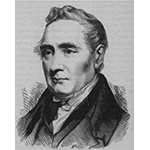
The Railway Revolution
With a year’s advance over the opening of the first steam railway line, the Stockton-Darlington, inaugurated in 1825, the Tuscan newspaper, Antologia, already questioned itself as to the utility and advantages of such a means of transportation. Fear for the high costs and doubts as to the effective economic return, hindered the realisation of a railway line in Italy for quite some time. The first one, the famous Naples-Portici that opened in 1839, remained an isolated case in the Kingdom of the Two Sicilies, and it was not until the following decade that the first railways, conceived to favour the transportation of men and goods, were built in the Grand Duchy of Tuscany and in the Lombardy-Veneto region under Austrian rule. In reality, the economic benefits almost always proved below expectations, but the repercussions on the scientific development of Italy at that time were enormous. The example and work of several pioneers of British railway engineering trained a generation of local technicians, Tuscan in particular, who had nothing to envy of foreign workers. For rolling-stock and locomotives, however, recourse continued to be made almost exclusive to British and American creations: the locomotives by Stephenson and Norris, in particular, took the upper hand in the railways of Tuscany.
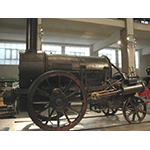
Technological Innovations
Though the first prototype of a steam-powered locomotive had already been experimented by Englishman Richard Trevithick in 1804, it was his fellow countrymen George and Robert Stephenson who in the 1820s invented the technical solutions which were to characterise these means of locomotion for more than a century. The necessity to obtain increased power led, on one hand, to the creation of larger boilers and, on the other, to the different positioning of the cylinders, which from vertical became horizontal, thus diminishing the vibrations caused by speed and consequently rendering the means more stable. While the Rocket (1829), rightfully considered the first "modern" locomotive, for the first time mounted a multi-tubular boiler, it was with the Planet in 1832 that the cylinders were positioned horizontally, while the later models by the Stephensons further improved performances by increasing the dimensions of the boilers (Long Boiler) and of the wheels. It was the Americans, however, who created a new type of running gear (the system of organs – wheels, treads, axles, etc. – between the track and the elastic suspension) with the introduction of a front bearing bogie with two axles, instead of the single axle adopted till then.
The new speeds attained by trains were extremely elevated for the period and, for safety reasons, in the neighbourhood of 25 miles per hour. This was a good deal below the theoretical potentials of locomotives, and presupposes the solution of serious problems tied to the ray of curves and the outflow of water from the track-bed of the rails. Natural obstacles such as hills, rivers or deep valleys constituted challenges for the engineers engaged in realising railway lines like the Subappennina or the Porrettana, which were overcome only thanks to increasingly more sophisticated instruments and means. In the case of Tuscany, the creation of an integrated and diffused railway system in a span of less than twenty years, also involved issues of a town planning nature. Cities witnessed the birth of a new type of public building, destined to become a powerful spot of aggregation, the railway station. Around it rose new districts, and production activities concentrated. These structures also offered architects the possibility to experiment to the utmost the stylistic and technical eclecticism of the new expressive language, popular in the 19th century, and consisting in the combined use of iron and glass.
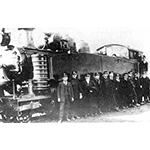
Travelling by Train
Though the steam railway constituted the cutting edge of nineteenth-century technology, quite a lot remained to be done as far as passenger comfort was concerned. Testimonies of the epoch indeed remind us that travelling by train must not have been risk-free even for first-class passengers: literature not infrequently recounts of sparks provoked by the locomotives that set clothes and fields on fire, or of the extreme conditions owing to jam-packed wagons, not to mention the discomforts of third-class wagons which were originally without roofing. Moreover, let’s not forget that trains rarely travelled on schedule, and that given the lack of a unitary policy, an integrated system of schedules and connections did not exist between the various railway companies. Great attention was instead placed on the problem of surveillance, given the numerous attacks perpetrated in the beginning by the landowners whose property had been expropriated and small transporters who with the coming of the railway had lost their jobs.
The Leopolda Railway
The idea of a railway line that joined the capital city of the Grand Duchy with its most important port, Livorno, had already been presented in 1826 by the marchese Carlo Ginori Lisci, soon after the first public railway line opened in England, the Stockton-Darlington. Premature for the Tuscany of the epoch, the project was again taken into consideration only a decade later by Luigi Serristori and Piero Dini Castelli. Despite meticulous market research to sound out the situation in the commercial field, and the efforts sustained to find entrepreneurs interested in financing the undertaking, the two promoters saw themselves bypassed by the powerful Florentine banker Emanuele Fenzi and Livornese businessman Pietro Senn who, thanks to greater financial security and the support of influential personages, succeeded in obtaining the concession for the new railway from the Grand Duke. Due to the inexperience of Italian engineers, work direction was entrusted to the Englishman Robert Stephenson, the most famous railway engineer of the time, though he later deferred most of the work to his assistants, William Hoppner and Robert Townshend. Among the various routes proposed, one was chosen which passed through Empoli, Pontedera and Pisa: in 1844, the Livorno-Pisa tract was inaugurated, while in 1845, William Bray who had succeeded Hoppner, succeeded in taking the line up to Pontedera, at the same time also inaugurating the freight service. One year later, the railway reached Empoli, and in 1848, the line could be considered as completed. The undertaking was such a success that Fenzi decided to immortalise it in his family coat of arms in which a steam locomotive is depicted between the Cathedral of Florence and the Pisans’ Lighthouse of Livorno.
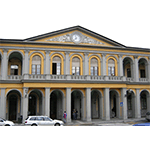
The Subappennina Railway
The positive outcome of the first Tuscan railway experiment induced numerous private companies to present Grand Duke Leopold II new projects for another line that would join the capital city to Pistoia and which, in honour of the ruler’s wife, would be called Maria Antonia. The commission, granted to the Societą Italiana ed Austriaca, was entrusted to engineer Isidore Kingdom Brunel who, in turn, delegated the job to Benjamin Herschel Babbage. The construction of the first stretch, between Florence and Prato, took about three years (from the second half of 1845 until February 1848) and was contested by the local population, tired of the continuous inconveniences they were subjected to. It was precisely the problems of a social and technical nature that also appeared for the second tract that convinced the concessionaires to grant the commission to the Anglo-Italian Company. The direction of works was thus entrusted to Thomas Woodhouse who succeeded in bringing the undertaking to its conclusion in July 1851.
At the same time as the realisation of the first stretch of the Maria Antonia, Austrian engineer Enrico Pohlmeyer had realised the brief Pisa-Lucca tract, inaugurating it in 1846. Passing through the Duchy of Lucca, which was only annexed to the Grand Duchy of Tuscany in 1847, the Lucchese Railway was to all effects the first Italian railway to join two sovereign states.
Greater problems were instead encountered for the tract that was to join Lucca and Pistoia, completing the sub-Apennine route from Florence to Pisa. Once again entrusted to Pohlmeyer, work indeed suffered a standstill faced with the difficulties encountered in crossing the natural barriers formed by the Pescia River and, especially, by the hills of Serravalle. Decisive in this sense were the intervention of Tommaso Cini, who succeeded the Austrian engineer in the direction of works, and the interest of capitalist Michelangelo Bastogi who imparted new vitality to the undertaking. Cini redesigned the bridge over the Pescia several times in response to the protests of the population and the paper producers of the area, worried for the narrowing of the river bed. Analogously, the tunnel of Serravalle was redesigned, lengthening its route in order to decrease its slope. While the Lucca-Pescia tract could be considered concluded in 1847, the railway reached Montecatini only six years later, while the completion of the entire line, with the opening of the tunnel of Serravalle, was achieved in 1859.
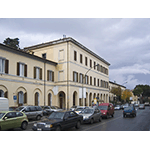
The Tuscan Central Railway
The idea of a railway that, departing from the route between Florence and Livorno, would reach Siena dates to 1842. The promoters of the new line were Giuseppe Pianigiani and Luigi Serristori formerly involved in the project for the Leopolda Railway, respectively in the capacity of engineer and organisation consultancy), but it was businessman Policarpo Bandini who directed the undertaking. In this case too, the numerous technical problems that emerged, mainly concerning crossing Mount Arioso, in addition to the ferocious criticism levelled at Pianigiani because of the tortuousness of the route he originally proposed, slowed down work. Begun in 1846, the new line became completely operative in 1850, thanks to the use of English tracks and locomotives.
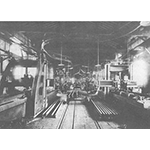
The Aretina (Ferdinanda) Railway
In the same years that the railway for Siena was being planned, various proposals were put forward for a railway that would lead up to Arezzo. The progress of the new line was initially commissioned to Tuscan engineer Francesco Guasti who in 1846 was replaced by Francesco Del Greco and Camillo Giordanengo. Delayed by Leopold’s undecided attitude, the entire affair was heavily conditioned by the mysterious disappearance of the project, which caused the deferment of the matter until the early 1850s. It was in this period that in view of realising a railway which from the north would descend to Rome, the competition with the Sienese line rekindled the debate on the Aretina. Thanks to a strong campaign to arouse public opinion conducted by the Municipality of Arezzo, Del Greco was able to start earthwork between Rovezzano and Pontassieve already in 1852, but the situation of extreme uncertainty as to finding capital led to another deadlock. The project, which originally planned for several tracts with double tracks and others with a single track, was finally entrusted to Frenchman Joseph Ducros who assigned the work to 4 different groups. The solution proved to be anything but successful, and in 1859, for reasons of safety, the Ministry for Public Works prohibited opening the only tract that was theoretically ready, that is to say the one up to Pontassieve. The affair was concluded only in 1866 with the arrival of the railway to Ponte San Giovanni, and the consequent link-up with the Ancona-Roma line.
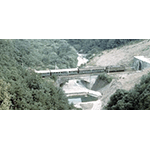
The Porrettana Railway
Former protagonist of the Subappennina affair, in 1845 Tommaso Cini proposed the project for a railway that, connecting Pistoia to Porretta, would have put Tuscany in communication with the northern states. At length opposed by the supporters of a line that would pass through Prato and the Bisenzio Valley, instead of the Reno Valley, the project was approved only after the death of its promoter in 1852. In the meantime (1851), the Grand Duke of Tuscany, along with the Papal States, the Duchies of Parma and Modena and the Austrian Government, undersigned an agreement that decreed the creation of a trans-Apennine railway that would connect Pistoia and Piacenza. Work on the Tuscan tract began around 1856. Despite the numerous difficulties offered by the territory, which required deviating the Reno River and creating some 47 tunnels along a course of 130 kilometres, the astute direction of French engineer Jean-Louis Protche made it possible to inaugurate the railway in 1863.
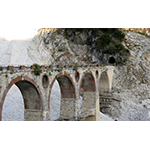
Complementary and Industrial Railways
The race to progress that characterised the 1840s and 1850s led to a proliferation of projects that for technical and, at times, political reasons soon proved to be impracticable. Among these, one of the most debated was doubtlessly a railway line that could join the Tyrrhenian to the Adriatic, the realisation of which, however, exceeded the technical capabilities of the epoch. There were also merely speculative manoeuvres, the most striking of which was certainly the affair of the Maremmana railway, which obtained the capital but was never built.
Special mention must instead be made of several industrial railways, like the Carbonifera of Montebamboli in Maremma and, for the period following the unification of Italy, the Marble Railway in the Apuane Alps. In particular, the first was born between the middle and late 1840s to transport lignite from the mines at Montebamboli down to the sea, and functioned in part by animal traction (uphill), and in part by exploiting the force of gravity (downhill).
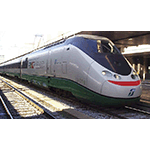
A Look at the Railway System after the Unification of Italy
With the birth of the Kingdom of Italy, Tuscany boasted a railway system of more than 250 km, second only to the networks of Piedmont and Lombardy-Veneto. The development of railways obviously did not stop with the Lorraines, and instead received a new boost from the need to create a more organic system on the national level. The process of railway nationalisation, however, was slow and problematic, and the direct management of the lines previously granted to private companies was assumed by the new Ferrovie dello Stato only in 1905. New constructions were erected and improvements in the technological field were adopted during the fascist period, but the second world conflict damaged most of the pre-existing structures and the recent electrical vehicles. The long and difficult reconstruction after the war led to the Tuscan railway assuming a fundamental role in the development of the entire national transports system, due mainly to the creation of the Rome-Florence "Direttissima" between 1978 and 1991, the first real high-speed railway line of the Italian network. Still under construction are the Tuscan tracts of the new super-fast line (TAV), which should cross the entire peninsula in a few years’ time.
****************************
Texts by Elena Fani
English translation by Victor Beard
Last update 07/gen/2008


